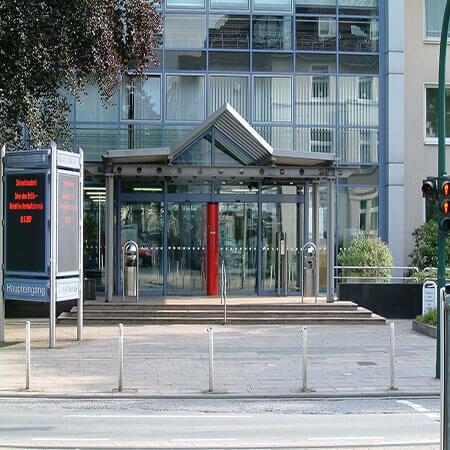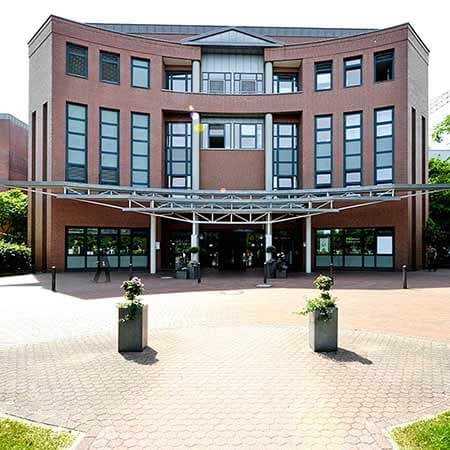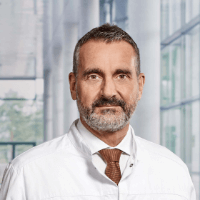Bypass Graft Repair for Aortic Coarctation treatment in Germany
Treatment prices are regulated by national law of the corresponding countries, but can also include additional hospital coefficients. In order to receive the individual cost calculation, please send us the request and medical records.

Department of Cardiothoracic Surgery
According to the Focus magazine, the Department of Cardiothoracic Surgery ranks among the top German medical facilities specializing in the surgical treatment of diseases of the cardiovascular system and lung cancer! The department offers the full range of surgical services for the treatment of diseases of the cardiovascular system, respiratory tract, including heart and lung transplantation, artificial heart implantation. The therapeutic options include aortic surgery, coronary artery bypass grafting, transplantation surgery, surgical treatment of heart rhythm disorders (arrhythmias), minimally invasive surgery, surgical treatment of the heart valves, including reconstructive interventions. All operations are performed using state-of-the-art technology and in accordance with the current recommendations of professional societies.






Department of Cardiac Surgery
The Department of Cardiac Surgery provides a full range of surgical treatment in its area of specialization. Special emphasis is placed on heart valve repair and replacement surgery, coronary artery bypass grafting, thoracic aortic surgery, adult congenital and acquired heart disease surgery, pacemaker and defibrillator implantation, and artificial heart implantation for severe heart failure. Many heart operations are performed using minimally invasive techniques, which has a positive effect on the healing of the surgical wound. Minimally invasive cardiac procedures also reduce surgical risks and contribute to a rapid recovery of the patient in the postoperative period. Surgical treatment of cardiac pathologies is performed in advanced operating rooms equipped with the latest technology. The cardiac surgeons of the department successfully perform routine and complex surgical procedures, saving the lives of thousands of patients. The specialists work in accordance with current clinical protocols and follow the recommendations of the German Society for Thoracic and Cardiovascular Surgery (DGTHG).


Department of Cardiothoracic Surgery and Vascular Surgery
The Department of Cardiothoracic Surgery and Vascular Surgery provides effective surgical treatment for diseases of the heart, respiratory system, and blood vessels. The team of cardiac surgeons operates on patients with heart valve pathologies, coronary heart disease, heart failure, and heart rhythm disturbances. In the field of thoracic surgery, the key focus is on the surgical removal of lung tumors and lung metastases. The specialists in this area also perform surgery to repair chest wall deformities. In the field of vascular surgery, interventions for abdominal and thoracic aortic aneurysms are most often performed here. The department's vascular surgeons are also exceptionally competent in the treatment of peripheral occlusive arterial disease. A great advantage for the department's patients is that almost all surgical interventions are performed using minimally invasive techniques, so there is no need for a long postoperative recovery. The department's operating rooms are equipped with state-of-the-art technology. This allows for effective and safe treatment. The priority is always personalized medical care for patients.






Many patients from around the world come to German hospitals to treat heart disease. Hospitals in Germany are well equipped, employ highly qualified cardiac surgeons, and practice modern types of surgical interventions. You can travel to Germany to undergo treatment of aortic coarctation. Several types of operations are performed in German hospitals, including aorto-aortic vascular graft placement, which is indicated for recurrent aortic coarctation after previous surgical repair. You are welcome to visit the Booking Health website if you want to undergo your treatment in Germany. On our website, you can find out the cost of treatment in Germany, compare prices in different German hospitals, and find a medical care program at a favorable price.
Content
- The essence of bypass grafting for aortic coarctation
- Who may be a candidate for bypass grafting for aortic coarctation?
- How is bypass grafting for aortic coarctation performed?
- Benefits of bypass grafting for aortic coarctation
- Where to undergo your bypass grafting for aortic coarctation repair?
The essence of bypass grafting for aortic coarctation
In 1973, C. Weldon first described the method of forming a bypass graft for the thoracic aorta during its coarctation. Although several operations already existed at that time, the goal of developing a new treatment method was to reduce the risk of complications.
Bypass grafting involves the formation of a bypass graft, which is a new path for the movement of blood around the narrowed site. This means that doctors create an additional blood vessel (a graft) into which blood enters above the narrowing of the aorta and from which it returns to the aorta below the narrowing. This type of bypass grafting is called an aorto-aortic bypass. The original technique involved the formation of a bypass graft between the aortic arch and the descending aorta.
Who may be a candidate for bypass grafting for aortic coarctation?
Bypass grafting is a rare type of surgery to repair coarctation. The main treatment methods are the removal of the narrowed area with an end-to-end anastomosis or with aorta replacement surgery, plastic repair with synthetic flaps or subclavian flaps, as well as balloon angioplasty, which is a minimally invasive procedure performed from inside the blood vessels.
Surgical repair with bypass grafting may be indicated in the following cases:
- aortic coarctation repair after a previously performed operation (recoarctation) in adult patients;
- a significant length of the narrowed area of the isthmus and the distal aortic arch;
- a low resistance of the brain to a lack of blood supply, which makes it impossible to clamp the carotid arteries;
- a significant adhesive process (usually caused by previous operations) that prevents standard interventions for the treatment of aortic coarctation from being performed.
How is bypass grafting for aortic coarctation performed?
Surgical restoration of blood flow through the aorta by forming a bypass graft is performed under general anesthesia. A sternotomy and a right- or left-sided thoracotomy can be used as a surgical approach. The operation can be performed with or without connecting the patient to a heart-lung machine. Basically, doctors perform a right-sided thoracotomy and do not connect the patient to a heart-lung machine, which reduces the risk of complications.
During the operation, a doctor makes an incision in the fifth intercostal space, opens the pleural cavity, retracts the right lung up and forward, and isolates the thoracic segment of the aorta for up to 10 cm. The right intercostal arteries are ligated. A prosthesis about 20 cm long is sutured with its lower end to the descending aorta. The lung is then retracted back and down, the pericardium is dissected, and the ascending aorta is isolated. The upper end of the artificial graft is placed, and its tightness is checked.
At the end of each stage of the operation, the tightness of the implanted vascular graft is checked. The blood flow through the aorta is then restored. Patients require pleural and pericardial drainages (tubes remain in the thorax for some time to drain fluid).
Benefits of bypass grafting for aortic coarctation
The benefits of this surgical treatment for patients lie mainly in the safety of the surgical repair. During the operation:
- there is no risk of damage to the lung, intercostal arteries, aorta, or the recurrent laryngeal nerve;
- there is no need to clamp the aorta in the area of degenerative changes of the walls;
- the method of parietal aortal pressing is used, which significantly reduces the risk of brain complications due to circulatory failure;
- the risk of developing spinal complications is almost zero;
- there is no need for hypothermia (cooling) or connection to a heart-lung machine;
- a less traumatic single-pleural thoracotomy is performed, which allows patients to reduce their recovery period after surgery;
- tracheal and esophageal compression can be simultaneously eliminated by dissecting the compressing structures.
Where to undergo your bypass grafting for aortic coarctation repair?
You can undergo your diagnostics, surgical treatment for aortic coarctation repair, and follow-up recovery in one of the German hospitals. In Germany, you will find effective and safe treatment, comprehensive recovery, and high-quality care after surgery. Bypass grafting is performed with a minimal risk of complications. This operation is usually performed without connecting the patient to a heart-lung machine.
If you want to receive medical care in one of the German hospitals, you can go to the Booking Health website. On our website, you can find out the cost of treatment in Germany using various procedures. Prices in German hospitals will be lower for you due to the lack of high taxes for foreign patients.
When you choose medical services in hospitals abroad through the Booking Health service, you will receive insurance that protects you against expenses unforeseen by your medical care program. The cost of treatment in Germany will not increase for you, even if there is a need for additional procedures, as the insurance will cover any unforeseen costs.
When you make your treatment appointment through Booking Health, you will be provided with travel arrangements. Our experts will assist you in selecting a hospital and scheduling an appointment on your preferred dates. They will also book a hotel room and airline tickets, meet you at the airport, and take you to the German hospital by car.
Authors:
The article was edited by medical experts, board-certified doctors Dr. Nadezhda Ivanisova and Dr. Vadim Zhiliuk. For the treatment of the conditions referred to in the article, you must consult a doctor; the information in the article is not intended for self-medication!
Sources:
ECR - European Cardiology Review

